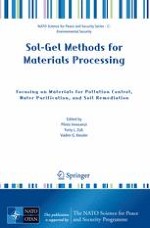Sol-gel processing is a soft-chemistry method to obtain functional materials at low temperatures. This route can be used to produce very sophisticated nanomaterials and to tailor the materials to very specific applications. Adsorption and detection of pollutants, water purification and soil remediation represent challenging fields of application that can be exploited by sol-gel materials. In this volume several contributions from invited speakers and participants at the NATO advanced research workshop on "Sol-gel approaches to materials for pollution control, water purification and soil remediation", which has been held in Kiev, Ukraine on October 2007, are reported. The book offers a wide and updated overview of the most advanced sol-gel methods for materials processing and at the same time presents several case studies concerning possible solutions for environmental issues. General articles on sol-gel from the invited speakers and focused research articles allow getting inside sol-gel applications on this very important field.
